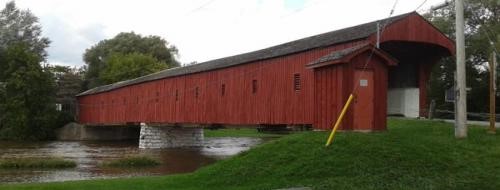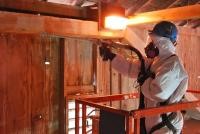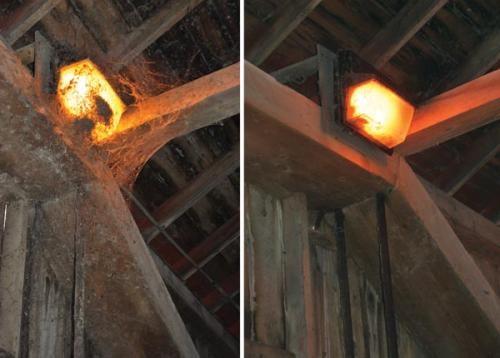Case Study: Historical Restoration and Preservation of the Kissing Bridge
 Technique Used: Dry Ice Blasting
Technique Used: Dry Ice Blasting
Location: Waterloo, Ontario
Service: Historical Restoration
Constructed in the early 1880s, the historic Covered Bridge has lived to play a significant role which goes beyond its transportation function. For many centuries, the Covered Bridge has functioned as a familiar and distinctive landmark which contributes to a strong sense of place and helped to tell the story of the region of Waterloo.
Known as the “kissing bridge” due to the purported tradition of the toll being a kiss, the second oldest surviving bridge in the region was built completely out of wood. Over time, hardy materials have been used to replace the supports, piers, and deck.
The Situation
 Many tourists from different parts of the world come to visit Waterloo to experience the scenic beauty that the Covered Bridge offers. With more tourists, there comes more revenue—and with more revenue, the government is able to build more schools, social amenities, and road infrastructure to improve the living standards. However, without its structural originality, it will not attract many visitors, hence the need to continue attempting to restore it to its original form.
Many tourists from different parts of the world come to visit Waterloo to experience the scenic beauty that the Covered Bridge offers. With more tourists, there comes more revenue—and with more revenue, the government is able to build more schools, social amenities, and road infrastructure to improve the living standards. However, without its structural originality, it will not attract many visitors, hence the need to continue attempting to restore it to its original form.
In 1904, the government began a major restoration project in an attempt to reinstate the bridge into its original form when it was closed for the first time as workers covered the original oak floor with plank. More than 2 decades later, the wooden trusses were replaced, followed by repeated replacement over time up to this date. Today the modern Covered Bridge comprises of a combination of wood, stone, steel, asphalt and concrete—all these components have helped to preserve its originality and structural integrity.
While the responsibility of the preservation of this historic landmark largely lies on government, local communities also place huge importance on keeping the bridge in good working order, and ensuring it is aesthetically pleasing too.
 The Solution
The Solution
The professionals at Wickens were called in to perform dry Ice blasting, ensuring the bridge retains its pleasing interior. Dry ice blasting was chosen as a method of cleaning due to its ability to gently clean without causing lasting damage to the makeup of the bridge itself.
It’s also an environmentally-sound option – for councils across the country, a low carbon footprint is a pre-requisite when obtaining services, and dry ice blasting certainly comes in as one of the most eco-friendly methods of cleaning since there is no secondary waste created.
The Result
The Covered Bridge was successfully restored, and has been involved in countless social events to date. The region of Waterloo is recognised globally for this magnificent structure, being marketed in countless tourism brochures. Thanks to the application of dry ice blasting, cleaning this historical structure no longer carries the threat of damage it once did.
For more information on our historical restoration process, contact Wickens today!
- Buying vs. Renting: How to Choose the Right Option for Dry Ice Blasting Equipment - June 16, 2025
- Why Dry Ice Blasting is the Optimal Solution for Mould Remediation in Industrial and Commercial Buildings - March 14, 2025
- Why Renting Dry Ice Blasting Equipment Is a Smart Move for Your Business - January 28, 2025

 The Solution
The Solution